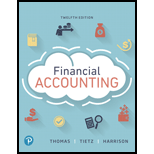
Concept explainers
(Learning Objectives 1, 4, 5, 6: Apply GAAP for revenue, receivables, collections, and uncollectibles using the percent-of-sales method; account for notes receivable) Lincoln Delivery Corporation is an overnight shipper. Since it sells on credit, the company cannot expect to collect 100% of its
| December 31, | ||
| 2019 | 2018 | |
| Accounts receivable............................................. | $4,300 | $3,900 |
| Less: Allowance for uncollectible accounts.......... | (190) | (210) |
| Accounts receivable, net...................................... | $4,110 | $3,690 |
During the year ended December 31, 2019, Lincoln earned service revenue and collected cash from customers. Assume uncollectible-account expense for the year was 3% of service revenue on account and that Lincoln wrote off uncollectible receivables and made other adjustments as necessary (see below). At year-end, Lincoln ended with the foregoing December 31, 2019, balances.
Requirements
- 1. Prepare T-accounts for Accounts Receivable and Allowance for Uncollectible Accounts, and insert the December 31, 2018, balances as given.
- 2. Journalize the following transactions of Lincoln for the year ended December 31, 2019 (explanations are not required):
- a. Service revenue was 532,600 million, of which 15% is cash and the remainder is on account.
- b. Collections from customers on account were $26,364 million.
- c. Uncollectible-account expense was 3% of service revenue on account.
- d. Write-offs of uncollectible accounts receivable were $851 million.
- e. On December 1, Lincoln received a 2-month, 9%, $135 million note receivable from a large corporate customer in exchange for the customer’s past due account; Lincoln made the proper year-end
adjusting entry for the interest on this note. - f. Lincoln’s December 31, 2019, year-end bank statement reported $40 million of non-sufficient funds (NSF) checks from customers.
- 3.
Post your entries to the Accounts Receivable and the Allowance for Uncollectible Accounts T-accounts. - 4. Compute the ending balances for Accounts Receivable and the Allowance for Uncollectible Accounts and compare your balances to the actual
- 5. December 31, 2019, amounts. They should be the same. How much does Lincoln expect to collect from its customers after December 31, 2019?
- 6. Show the net effect of these transactions on Lincoln Delivery’s net income for the year ended December 31, 2019.
Want to see the full answer?
Check out a sample textbook solution
Chapter 5 Solutions
Financial Accounting Plus MyLab Accounting with Pearson eText -- Access Card Package (12th Edition)
- Don't use ai given answer accounting questionsarrow_forwardAKA works in an accounts payable department of a major retailer. She has attempted to convince her boss to take the discount on the 3 / 25 net 90 credit terms most suppliers offer, but her boss argues that giving up the 7% discount is less costly than a short-term loan at 9%. Prove to whoever is wrong that the other is correct. (Note: Assume a 365-day year.) The cost of giving up the cash discount is _%. (round to two decimal places). Give solution to this financial accounting Problem.arrow_forward??!!arrow_forward
- Which account is considered a permanent account ?arrow_forwardAfter the accounts are adjusted and closed at the end of the year, accounts receivable have a final balance of $750,000 and an estimate of $93,000 is estimated for doubtful accounts. What is the net realizable value of accounts receivable? Answerarrow_forwardStep by step answerarrow_forward
- What is the operating margin?arrow_forwardProvide correct answer general accounting questionarrow_forwardAfter the accounts are adjusted and closed at the end of the year, accounts receivable have a final balance of $750,000 and an estimate of $93,000 is estimated for doubtful accounts. What is the net realizable value of accounts receivable?arrow_forward
- Principles of Accounting Volume 1AccountingISBN:9781947172685Author:OpenStaxPublisher:OpenStax College
 Individual Income TaxesAccountingISBN:9780357109731Author:HoffmanPublisher:CENGAGE LEARNING - CONSIGNMENT
Individual Income TaxesAccountingISBN:9780357109731Author:HoffmanPublisher:CENGAGE LEARNING - CONSIGNMENT



